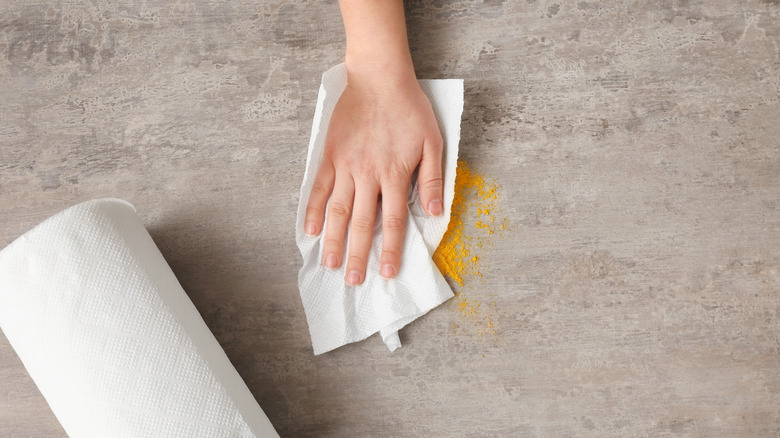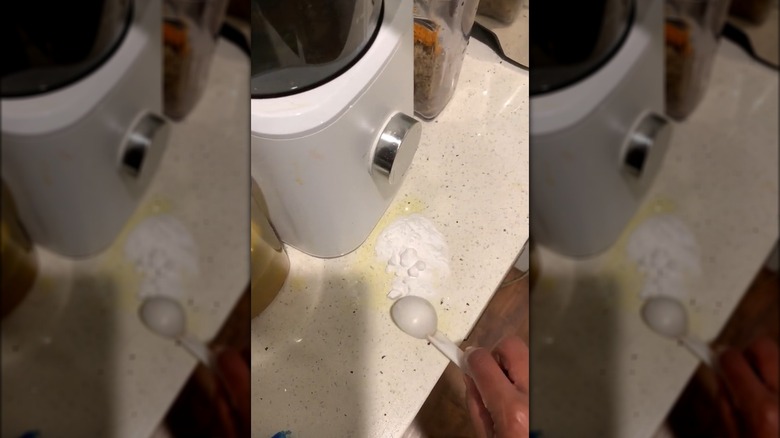The Best Way To Remove Yellow Turmeric Stains From Kitchen Countertops
As anyone who's ever whipped up a recipe using turmeric will know, it's not exactly the tidiest spice out there. It's far from it as turmeric has a reputation for staining everything from clothing to countertops — and its bright yellow hue doesn't exactly lend itself to being easily covered up. That said, if you've recently acquired a new, sunshine-hued splotch in your kitchen, don't panic. Applying some baking soda to the area and then wiping it off with a dampened sponge or cloth is an easy and effective way to lift the marks, though it does depend on what type of surface with which you are dealing.
There's a scientific reason why the baking soda hack is such a great option for those struggling with turmeric stains. Speaking to The Guardian about the reason why the spice is so difficult to remove from fabrics, LTC Worldwide's Steve Anderton explained that turmeric contains oil. That explains why more porous countertops, like marble, are also susceptible to yellow marks that don't budge even after being washed with traditional, water-based soaps. It only makes sense, then, that baking soda — which is known for being able to cut through oil — is a great go-to when you're dealing with the messy after-effects of the spice.
So, without further ado, if you've got a turmeric stain that needs cleaning, head into your pantry and grab that box of baking soda. Yellow stains, your days are numbered!
Pour some baking soda over the stain and let it sit
To remove a pesky turmeric stain from your kitchen countertop (though be cautious with marble — more on that later), mix together some water and baking soda. The paste should be as thick as possible so that the baking soda can work its magic. In fact, you could even forego a paste and simply dampen the surface slightly before applying the baking soda directly to it, a la TikToker @1kibre. The key is that the baking soda sits on the affected area for at least 20 minutes. If your countertops are non-porous (think laminate and quartz), you can even leave it on slightly longer.
Whether you decide to leave it on longer or clean it as soon as 20 minutes have passed, once the time is up, use your cloth to gently rub the stain (emphasis on gently), and it should look as good as new! Go ahead and clean the entire area with your regular countertop detergent — because one downside of cleaning with baking soda is that it isn't a disinfectant. Stain still there? Start the process again, and try to leave it on slightly longer than before.
However, there are some things to keep in mind, if you do plan on putting this hack into action.
Don't use this hack on just any countertops
While this hack is an excellent solution for many countertops, if your countertops are marble, it's best to proceed with caution when using baking soda. Despite being known as a relatively mild exfoliant, there is a chance that it could damage the stone. Your best bet, when cleaning turmeric off marble, is to wipe it up the moment you see it to avoid it setting. Alternatively, good old dish soap and warm water are a safe bet.
Granted, there is some debate about using baking soda on marble. It's generally seen as an alternative to scrubbing the marble with the dish soap formula. So, if you're itching to try this hack on stains that have set, RSC recommends using it on the affected area, but leaving it on for less than a minute (the shorter, the better). However, even then, this isn't a solution to whip out every time you cook with turmeric — and Granite Gold even suggests re-sealing the stone afterward. We'd also recommend speaking to your specific supplier beforehand, to be safe.
As for which surfaces are safe for the baking soda hack, laminate is a go, and Caesarstone notes that it's fine for quartz, too. However, as with marble, it's never a bad idea to confirm that with your supplier. If it is a safe option, lucky you, because baking soda is one of the best ways to nix those annoying turmeric stains for good.


